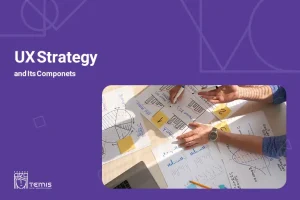Do you know what the most integral part of product design is: It’s UI elements or user interface elements, Do you know what are ui elements? Whether it’s a web design or mobile app, desktop, Augmented Reality, or Virtual Reality app. All products are built around UI elements. They add interactivity to a user interface design.
Designers don’t usually draw UI elements when building web pages or mobile apps. They usually start with a ready repository of UI elements, and if they’re backed with code, interactive UI components. You will use UI elements to create a visual language as a user interface designer (UI designer) or web developer. User Interface (UI) design is a crucial aspect of creating digital products and applications that are visually appealing but also user-friendly and functional. This article will explore the fundamental UI design elements and delve into their significance in crafting successful UI and UX design services.
Table of Contents
UI Elements: Definition
UI elements allow for a great user experience and well-designed functionalities. The user interface (UI) elements we use to create apps and websites are what we call the “user interface”. The UI design elements add interactivity to the user interface and provide touchpoints for users as they navigate around. Button, scrollbars and menu items are all good examples.
Users may become confused or lost if you break design patterns. UX design is based on the design patterns your users are most familiar with. To prevent future problems, designers use well-known UI elements.
Most used UI design elements are here prepared for you:
1-Typography
Typography plays a pivotal role in UI design. From fonts to formatting, this criterion covers the essential design elements. Proper typography choice is essential for content to be readable and visually appealing. The importance of typography lies in its ability to convey a digital product’s tone, hierarchy, and overall branding.
- Legibility: UI designers must prioritize legibility to ensure users can read and comprehend the content effortlessly. Proper font selection and size are key factors in achieving this.
- Hierarchy: Typography aids in creating a visual hierarchy by using different font weights, sizes, and styles. This guides users’ attention and emphasizes essential information.
- Branding: The choice of fonts can also reinforce a brand’s identity. For example, a tech company might opt for a modern, sans-serif font to convey innovation and efficiency.
2-Color
Color is a potent tool in UI design, influencing users’ emotions, perceptions, and interactions with a digital interface. Effective color choices can evoke specific feelings and help convey the product’s message.
- Emotional Impact: Colors have psychological associations; for instance, blue often represents trust and reliability, while red can evoke excitement or urgency. UI designers use these associations strategically to create desired user responses.
- Consistency: A well-defined color scheme fosters consistency throughout an application or website. This consistency reinforces the brand identity and helps users navigate the interface intuitively.
- Accessibility: UI designers must also consider color accessibility, ensuring text remains readable for visually impaired users. This involves using contrasting colors and providing alternative text for color-coded information.
3-Layout and Grids
The layout of a user interface dictates the arrangement of elements on a screen. Grid systems are essential tools for organizing content in a visually pleasing and structured manner.
- Visual Harmony: Grids create a sense of order and balance in UI design. Elements are aligned with precision, providing a polished and harmonious appearance.
- Responsive Design: Grids are vital for responsive design. They enable content to adapt gracefully to various screen sizes, ensuring a consistent user experience across devices.
- Efficiency: Well-defined layouts and grids make it easier for users to find information quickly. It minimizes cognitive load, enhancing usability.
4-Icons and Imagery
Icons and imagery are visual elements that help users quickly understand and interact with an interface. They convey information and meaning in a concise and universally understood way.
- Recognition: Icons are precious for conveying actions and concepts without lengthy explanations. For example, a magnifying glass icon universally represents a search function.
- Visual Engagement: High-quality imagery and icons can captivate users and make the interface more engaging. They contribute to the overall aesthetic appeal of the design.
- Simplicity: Icons and imagery should be simple and clear. Overly complex visuals can confuse users, defeating their purpose.
5-Buttons and Interactive Elements
Buttons are fundamental interactive elements in UI design. They invite user actions and guide them through the interface.
- Clickability: Buttons and interactive elements must be distinguishable and inviting to click or tap. Their design should make it evident that they serve a purpose.
- Consistency: By maintaining consistency across buttons, UI designers contribute to an intuitive user interface.
- Feedback: Buttons should provide feedback when interacted with, such as changing color or shape, to acknowledge the user’s action.
6-Navigation Menus
Navigation menus are the roadmap of a digital product. They help users explore and access different parts of an application or website.
- User Flow: Well-designed navigation menus simplify user flow and make it easy for users to find the information or features they seek.
- Organization: The structure of navigation menus influences the organization of content. Logical grouping and categorization enhance the user’s experience.
- Mobile-Friendly: In mobile UI design, navigation menus often collapse into a more compact form, such as a hamburger menu, to save screen space while maintaining accessibility.
7-Forms and Input Fields
Forms and input fields are essential for user interaction, especially in applications that require user-generated content or data input.
- Usability: User-friendly forms and input fields improve usability. Clear labels, appropriate placeholders, and input validation create a positive user experience.
- Error Handling: Effective error messages and indicators help users correct mistakes when filling out forms, reducing frustration and abandonment rates.
- Accessibility: Designers should consider accessibility standards when designing forms, ensuring they are usable by individuals with disabilities.
8-Whitespace
Whitespace, or negative space, is the empty area between UI elements. It plays a crucial role in visual aesthetics and usability.
- Visual Clarity: Whitespace helps separate and define UI elements, making the interface less cluttered and easier to understand.
- Focus: It directs the user’s attention to important content by providing visual separation. Well-utilized whitespace can guide users through the interface.
- Readability: Adequate spacing between text and other elements improves readability and prevents visual fatigue.
9-Micro-interactions
Micro interactions are subtle animations or responses to user actions. They provide feedback, enhance usability, and add an element of delight to the user experience.
- Feedback: Micro interactions inform users that their actions have been recognized, which is particularly important in digital interfaces.
- Engagement: Thoughtfully designed micro-interactions can engage users and make the interface more responsive and interactive.
- Guidance: They can guide users through complex processes like loading screens or step-by-step tutorials.
Other UI Design Elements
User interface elements usually are one of the following four categories:
- Input Controls
- Navigation Components
- Informational Components
- Containers
Now, look at the other common UI elements of these four categories you may run into.
-
Input controls
It allows users to input information into the system. For example: If you need your users to tell you what country they are in, you’ll use an input control to let them do so.
-
Checkbox
A checkbox allows the user to choose one or more options from a group. A checkbox is exactly what its name implies in UI design. Checkboxes are best presented in a vertical list. This element is often used in forms and databases.
-
Toggles
Toggling buttons allow the user to switch between two states. These buttons are most effective when they are clearly visible.
-
List boxes
List boxes are almost like checkboxes. They allow users to select multiple items simultaneously but more compactly.
-
Date and time picker
Date and time pickers allow users to pick dates and times. The advantage of using pickers over input fields is the information is consistently formatted and input into the system.
-
Dropdown list
Dropdown lists are a controversial UI element. The dropdown list allows users to choose an item from a “drop down” list once they click it. To help users recognize the action, you might add text to the field such as “Select one”.
-
Pagination
Pagination divides the content between pages, allowing users to skip between pages or go in order through the content.
-
Breadcrumb
These links leave a trail of links that help users find their current location within a website. By providing a clickable trail that links to the next pages, breadcrumbs allow users to pinpoint their current location in the system.
-
Tag
In UI design, tags allow users to find content in the same category. They are essentially labels that help to mark and categorize the content. Moreover, some tagging systems also allow users to apply their own tags.
-
Search Field
Search boxes allow users to type a keyword (or phrase) into a search box and then submit it to search. They are commonly represented as an input field with a little magnifying glass.
-
Sliders
Sliders, also known as a track bar, are a common UI element used for selecting a value or a range of values. The format of the interface and other information on the screen are not affected by the user changing the value.
-
Informational components
They share information with users.
-
Message Boxes
A message box is a small window that provides information to users and requires them to take action before they can move forward.
-
Modal Window (pop-up)
Modal windows are small boxes that contain content or messages. Modal windows require users to interact with them in order to return to the system.
-
Tool Tips
A tooltip is a way for a user to see hints as they hover over an item. It indicates the name or purpose of an item in an interface.
-
Notification
These little red dots will be found all over interfaces. Notifications are an update message that informs the user of something new. We can receive a notification if there was an error or if the process went well.
-
Progress Bar
A Progress bar allows users to visualize where they are after completing a set of steps. Progress bars are usually not clickable.
-
Containers
Containers hold related content together.
-
Accordion
An accordion can be described as a vertically stacked collection of items that use show/hide functionality. This allows users to expand or collapse portions of content. These allow users to quickly navigate through material and allow the UI designer more information in a limited space.
Conclusion
In the world of UI design, understanding and effectively implementing these fundamental UI elements are essential for creating interfaces that are not only visually appealing but also highly functional and user-friendly. Each element uniquely shapes the overall user experience, from typography ensuring readability to micro-interactions adding interactivity and engagement.
Successful UI design requires a harmonious blend of these elements, considering the specific needs and goals of the product or application. By maintaining consistency across buttons, UI designers contribute to an intuitive user interface.
FAQ
What are UI and UX design elements?
UX design focuses on creating a seamless and meaningful user experience by understanding user needs, researching, and designing intuitive interfaces. In contrast, UI design focuses on a product’s visual, interactive elements to create aesthetically pleasing interfaces.
How do you add UI design elements?
You can add directly from the action properties or through the UI elements pane of the flow designer. Each one of these action groups accepts a different type of UI element. UI automation actions accept desktop UI elements, while browser automation actions accept web UI elements.







